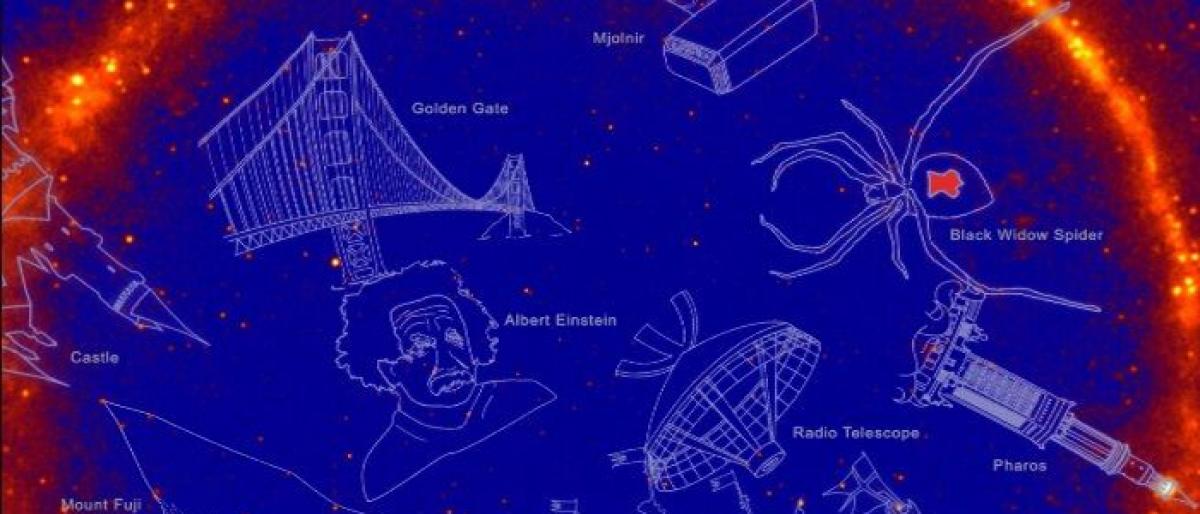Live
- Three persons admitted to hospital for diarrhea treatment
- First Star Outside Milky Way Captured: WOH G64 is 2,000 Times Larger Than the Sun
- Sikkim govt to constitute state Niti Ayog: CM Tamang
- CBI books Rajasthan narcotics inspector for Rs 3 lakh bribe
- Rajasthan bypolls: A tough contest between BJP and Congress
- Albania joins SEPA, paving way for EU integration
- Japanese government approves 250-billion USD economic package to ease price pain
- Six pharma companies to set up their units in Telangana
- The Unstable Events of a 17-Wicket Day in Perth: India vs Australia
- Dutch FM's Israel trip cancelled after Netanyahu's arrest warrant
Just In

For thousands of years, humans have looked up at the stars and ordered them into constellations the Hulk the TARDIS Schrdingers cat Not familiar with these Thats probably because you cant see them without a gammaray telescope and also, NASA just invented them
For thousands of years, humans have looked up at the stars and ordered them into constellations: the Hulk ... the TARDIS ... Schrödinger's cat. Not familiar with these? That's probably because you can't see them without a gamma-ray telescope — and also, NASA just invented them.
To highlight the first decade of discoveries recorded by NASA's Fermi Gamma-Ray Space Telescope, U.S. astronomers have connected the dots on the universe's invisible sources of gamma-ray energy. This allowed the researchers to map 21 brand-new constellations onto the celestial sphere. You won't see these shapes in the night sky; despite being the universe's most powerful sources of light, gamma-rays are invisible to human eyes. But you can see the shapes all on a new interactive websitecrafted by NASA scientists and artist Aurore Simonnet, of Sonoma State University in California.
"Developing these unofficial constellations was a fun way to highlight a decade of Fermi's accomplishments," Julie McEnery, a Fermi project scientist and an astrophysicist at NASA's Goddard Space Flight Center in Greenbelt, Maryland, said in a statement. "One way or another, all of the gamma-ray constellations have a tie-in to Fermi science." Since it was deployed in 2008, the Fermi telescope has been scouring the cosmos for sources of gamma-rays. These high-powered rays are invisible to us but hurtle constantly across space. They shine out of exploding stars, strobe off of spinning pulsars and radiate from the edges of unfathomably powerful black holes at the centers of distant galaxies. (According to NASA, about half of the universe's known gamma-ray sources fit into that last category.)
Within seven years of the telescope's deployment, Fermi had already mapped about 3,000 previously unknown sources of gamma energy exploding across the sky — about 10 times the number of sources known prior to the mission, according to NASA. Now cobbled into ersatz constellations, these gamma blasts take the form of world landmarks (like the Eiffel Tower and the Roman Colosseum), sci-fi spacecraft (like the starship Enterprise from "Star Trek" and "Doctor Who's" time-traveling TARDIS), and homages to icons of science like Einstein and the cardboard box that contains Erwin Schrödinger's living/dead cat. Perhaps the most elegant marriage of medium and message is the constellation of the Hulk, who owes his famous viridescent bod to a gamma-ray experiment gone wrong. Stargaze at all these new patterns in the sky — and see where they fall in relation to the 88 visible-light constellations we know and love — right here.
- Brandon Specktor
Source: Live science

© 2024 Hyderabad Media House Limited/The Hans India. All rights reserved. Powered by hocalwire.com







